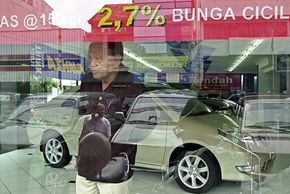When deciding to lease or buy a new vehicle from a purely financial perspective, you should look at the cost of driving the car over a period of several years. There are real costs that come along with a car. Maintenance, insurance, taxes, down payments and monthly payments all add to the car's total cost, which exceeds the dealer's asking price. Let's look at the real costs of a leased car and a purchased car.
Edmunds evaluated the costs of car ownership versus leasing, based on a new $20,000 car financed with a three-year loan or lease at 6 percent interest. What they found was that, after a five-year period, the real cost of owning a car was actually slightly higher than leasing. With monthly payments, down payments, maintenance, insurance, taxes, state fees and interest, the total cost of ownership came to $32,388 for five years. Under the same circumstances, the cost for leasing cars during a five-year period totalled $32,140.
Initially, it seems that leasing is a more affordable way to go. Especially if you become a seasoned lessee, who can avoid the extra fees and penalties, such as for extra mileage. But you must also take into account what happens after this five-year window. Very few people drive a car for only five years; if that were the norm, then leasing would be the way to go. So let's look at the 10-year life span of a car, using the same scenario that Edmunds provided.
When you lease, you begin again every three years: You make a down payment if necessary, you pay high insurance rates, low maintenance costs and you get the hassle-free experience of simply turning in your old car and picking up the keys for your new one. But leasing a car doesn't build equity like owning a car does.
After 10 years of owning a car, your insurance will decrease, your maintenance costs will increase, and you will have finished off the largest financial burden — the monthly payment — years ago. With a lease, you continue to make monthly and down payments, though the rest of the costs remain about the same. But when you add up all of the money you've spent over the last 10 years, you see a clear advantage of purchasing a car over leasing cars.
After adjusting for maintenance and other operational costs, you would have spent around $43,000 for that new $20,000 car you purchased 10 years ago. It's a staggering amount, but on the other hand, consider how much you would have spent leasing cars for the same 10-year period: Assuming there are no extra fees or penalties, you would have coughed up more than $64,000. Plus, you would have built no equity.
After 10 years, the new car you purchased will have depreciated a great amount. But it should still be worth a portion of its original value. For example, in 1998, a Toyota Camry LE went for about $21,000 [source: South Carolina Administrative Law Court].
In 2007, that same car in excellent condition was worth $4,075 as a trade-in [source: Kelley Blue Book]. You can use that trade-in amount as a down payment that will defray the cost of the next car's total cost and lower the monthly payments. So, after 10 years, the trade-in value of the car subtracted from the cost of owning the car for the past 10 years could bring the car's total cost down to less than $30,000.
For more information on cars, finances and related topics, visit the next page.

